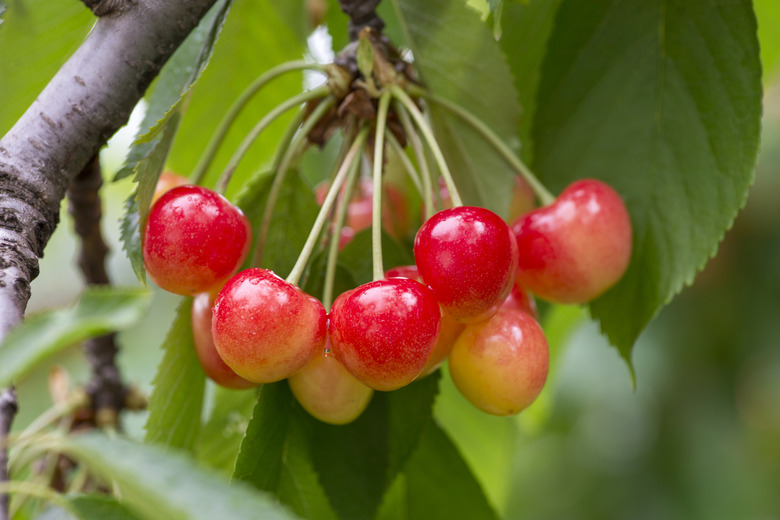Can You Ripen Cherries After They're Picked?
Cherries (Prunus spp.) are stone fruits produced on dwarf, semi-dwarf, and standard sized trees. When harvesting, pick only the ripe cherries, as the fruits don't ripen further once removed from the tree. Depending on the species and cultivar, you can grow cherries in U.S. Department of Agriculture plant hardiness zones 2 through 10.
Tip
Once picked, cherries don't ripen further. Wait until the fruits are plump, juicy, and fully-colored before harvesting.
Choosing Sour vs. Sweet Cherries
Sour cherries (Prunus cerasus), also known as pie cherries, are generally hardier than sweet cherries (Prunus avium). Sour cherries, such as Montgomery and Early Richmond, are hardy in USDA zones 4 through 8, though a few hybrid trees thrive down to USDA zones 2 and 3. Juliet and Carmine Jewel (Prunus fruticosa x cerasus), are hardy in USDA zones 2 through 7, and 3 through 8, respectively. Though some sour cherry cultivars are more sweet-tart than sour, most of the fruits are best used in pies, preserves, and fruit juices.
Sweet cherries prefer USDA zones 5 through 10, depending on the cultivar. While sweet cherries Bing and Rainier prefer zones 5 through 8, newer cultivars like Lapins and Starking Hardy Giant thrive in USDA zones 5 through 9. Royal Crimson Cherry, introduced by Zaiger Genetics in 2016, produces its sweet ripe cherries in USDA zones 8 through 10.
Other types of cherry trees include the ornamental flowering cherries (Prunus serrulata) and weeping hybrids (Prunus x yedoensis), which may produce small sour fruits best suited to feed the birds. These short-lived trees thrive in USDA zones 5 through 8. North America's native cherries, such as the black cherry (Prunus serotina), are hardy in USDA zones 3 through 9. Black cherries are also small and sour, but may be used for jams, jellies, and flavoring liquors.
Planting Cherry Trees
Cherry trees require full sun in a well-drained location. Consider the space available when selecting your tree. Standard sweet cherry trees grow up to 30 feet tall and equally wide, while semi-dwarf trees may reach 15 feet tall, and dwarf trees can grow up to 10 feet tall. Standard sour cherry trees grow 20 to 25 feet tall.
In late fall or early spring, dig a planting hole twice the width and half again as deep as the root ball. Space standard sweet cherry trees 20 to 30 feet and sour cherries 20 feet apart. Space semi-dwarf and dwarf trees 15 and 10 feet apart, respectively. Sweet cherry trees are not self-fertile; plant a second, compatible tree or select a tree with a second cultivar grafted to the same trunk to ensure a good harvest.
Plant the tree so the root ball is at the same depth as it was originally in the soil or container. Backfill, tamp gently, and water thoroughly to settle the soil around the roots.
Caring for Cherry Trees
Water newly-planted trees daily for the first two to three weeks after planting, then reduce watering gradually to once weekly or as needed. When the soil is dry to a depth of 2 inches, apply 10 gallons of water for every inch of the trunk's diameter. Also add a 3-to-4-inch layer of bark mulch under the tree, pulling it at least 4 inches from the trunk.
Fertilize in early spring with a 10-10-10 all purpose fertilizer or rake several inches of well-decomposed compost and manure over the soil, beginning 12 inches from the trunk and out to the canopy edge. Repeat when the tree flowers, but not after the tiny green cherries appear.
Harvesting the Ripe Cherries
Harvest the cherries when plump, juicy, and fully-colored. Bing cherries will turn a rich mahogany red, while Rainier fruits turn golden yellow with a red blush. Put on gloves, long sleeves, and safety goggles, then sterilize your pruners by dipping the blades in rubbing alcohol. Cut the stems so you don't damage the fruit.
Once harvested, cherries can be stored in the refrigerator for a couple of days. Preserve the fruits by freezing, canning, or dehydrating as soon as possible after the harvest.
